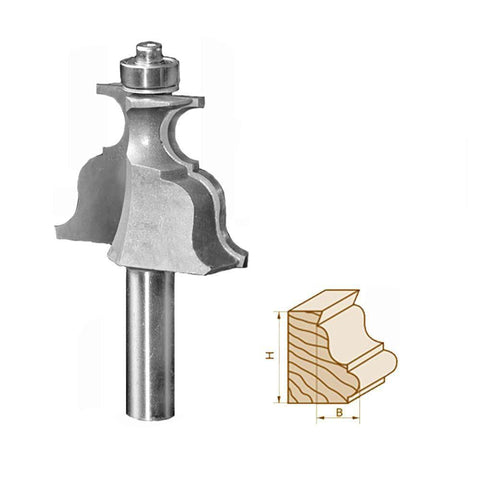Baseboards are an often-overlooked feature in many woodworking projects, yet they serve both a functional and aesthetic role in finishing off a room. Whether you're renovating a space or crafting custom trimwork, the quality of the baseboards can significantly affect the overall appearance of a room. Achieving clean, professional-looking baseboards doesn't require advanced skills, but it does require the right tools. Router bits for baseboards offer a versatile and efficient way to create custom profiles, smooth edges, and sharp details that elevate the look of your trim. These bits allow woodworkers and DIYers alike to transform basic baseboards into architectural features that add character and style to any room.
When it comes to router bits for baseboards, one of the key advantages is the ability to create distinct, custom profiles. Baseboards are available in a variety of pre-made designs, but the true magic happens when you add personalized touches. Router bits, with their range of profiles and shapes, allow you to craft unique edges that fit the overall design theme of the room. From traditional, elegant ogee and colonial profiles to sleek, modern straight lines, the right router bit can add sophistication and detail to baseboards with ease. A custom-cut profile can also make baseboards appear more expensive and intricate than their standard counterparts, offering an upscale look for a fraction of the cost of purchasing high-end trims.
One of the most commonly used router bits for baseboards is the round-over bit, which is used to soften the sharp edges of a baseboard, creating a more polished and professional appearance. These bits come in various radii, allowing woodworkers to choose the right amount of curvature to match the desired style. Whether you want a subtle, rounded edge or a more pronounced curve, a round-over router bit can help achieve the perfect finish. This simple yet effective tool helps to soften the typically harsh, angular edges of a baseboard, making it visually appealing and easier to clean.
For more intricate, detailed work, a cove router bit can be used to add a concave curve to the baseboard. This adds visual depth, enhancing the profile of the trim while providing a smooth transition between the floor and the wall. The cove profile is often used in traditional or more classical interior designs, and when applied to baseboards, it offers a charming, timeless look. For those looking to replicate period-specific design elements or add a touch of elegance to their trimwork, a cove router bit is an excellent choice.
Chamfer bits are also popular for baseboard work, especially when creating sharp, angular edges. The chamfer bit produces a beveled edge that adds clean lines and a modern, geometric aesthetic to baseboards. This style is ideal for contemporary homes or minimalist designs where simplicity and straight lines are key. Chamfer bits allow woodworkers to add subtle yet impactful details that complement modern decor while maintaining the visual weight and balance that baseboards provide.
The versatility of router bits extends beyond just profile creation; they are also essential in perfecting the fit of baseboards. When installing baseboards around corners or molding, router bits can help trim edges to ensure a seamless and snug fit. This is particularly useful when working with baseboards that need to meet other trim or molding, as router bits can refine edges and make precise cuts to ensure perfect alignment. With a flush trim bit, for example, you can easily trim baseboards to the exact length needed to match other trim pieces, achieving a clean, professional-looking joint with minimal effort.
Moreover, router bits designed for baseboards are highly efficient tools that save time and effort. Traditional methods of sanding, filing, or shaping edges by hand can be time-consuming and labor-intensive, especially when trying to achieve a consistent result across multiple baseboards. With a router bit, the work becomes faster and more consistent, allowing for multiple baseboards to be shaped and detailed in a fraction of the time. This efficiency is especially helpful when working on large projects, such as outfitting an entire house with custom trimwork, as the router bit enables you to achieve a high level of detail with less physical labor.
The material of the baseboard also plays a role in selecting the right router bit. Hardwoods like oak, cherry, or maple can be more challenging to work with, requiring router bits made from durable materials such as carbide-tipped steel. Carbide bits hold their sharpness for longer periods, ensuring clean cuts even when working with denser woods. On the other hand, softer woods like pine are easier to shape, but they still benefit from high-quality router bits that minimize tear-out and produce smoother finishes. Regardless of the material, the right router bit for the job ensures both the quality and speed of the work are maximized.
For woodworkers who want to enhance the appeal of their space, router bits for baseboards are an invaluable investment. Whether creating soft, rounded edges with a round-over bit or designing intricate profiles with a cove or ogee bit, these tools provide endless possibilities for customizing baseboard trim. They are not only essential for achieving clean, professional finishes but also enable woodworkers to inject creativity and personality into a room's design. The result is baseboards that elevate a room's aesthetic, providing a polished, custom look that enhances the overall appeal of the space. With the right router bits, your baseboards can become a statement feature that adds both charm and character to your home.

